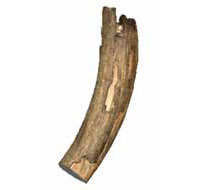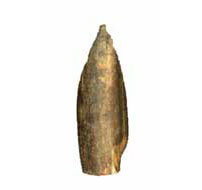|
A partial mammoth tusk collected on Melville Island during the CAE is one of the
most significant fossils collected in the north. Representing the northernmost
specimen of mammoth ever found, this fossil tusk (originally 36" long x 5.75"
diameter near the base) has been described and analyzed in a number of scientific
papers. A portion of the tusk was cut off one end and used for radiocarbon dating,
allowing scientists to determine that the tusk is about 22,000 years old. The
significance of the tusk was diminished by the lack of precise information on
exactly where it was found. The only locality reference, "near Cape James
Ross," suggested the tusk could have arrived on the shore with moving ice.
Fortunately, the time and precise place of collection were discovered during the
research for this virtual exhibition in 2002, making the specimen even more valuable
to palaeontologists. As recorded in Aarnout Castel's diary for September 1916,
the tusk was picked up inland from the coast, in the riverbed near "Storkersen's
Camp" near Peddie Point on Liddon Gulf:
"The four of us [Castel, Split, Pete, Storkerson] brought
the two sledes [sic] into camp. Coming along the river I found a piece of mastadon
or mammoth tusk about 2 feet long and 6 inch diameter" (Castel diary, September
14, 1916).
 |
 |
 |
Mammoth tusk.
3-D model: Paul Bloskie, © Canadian Museum of Nature;
specimen no.11833, accn. 403.
- Pointstream Version (311 Kb)
- Quicktime Version (158 Kb)
|
|
You need Pointstream 3DImagePlayer in order to manipulate this
3D image. Download this
plug-in. You must be using Microsoft Windows and Internet Explorer 4.0 or greater.
To rotate the image, click on it and move your mouse. To zoom in and out, right-click
on the image while moving your mouse.
QuickTime allows you to rotate the image horizontally.
Download
QuickTime player
|
 |
 |
 |
Mammoth tusk fragment.
3-D model: Paul Bloskie, © Canadian Museum of Nature;
specimen no.11833, accn. 403.
- Pointstream Version (406 Kb)
- Quicktime Version (141 Kb)
|
|
You need Pointstream 3DImagePlayer in order to manipulate this
3D image. Download this
plug-in. You must be using Microsoft Windows and Internet Explorer 4.0 or greater.
To rotate the image, click on it and move your mouse. To zoom in and out, right-click
on the image while moving your mouse.
QuickTime allows you to rotate the image horizontally. Download
QuickTime player
|
|
 |